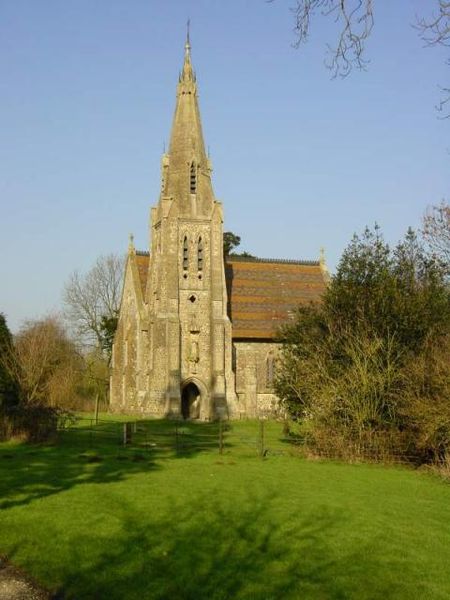St Catherine’s, Kingsdown.
St Catherine’s church, as far as is known it the only complete Anglican church by Edward Welby Pugin. Pugin was given free hand with the design, and the church has remained almost unchanged since being built.
The parish when the church was built, in 1865, only consisted of 96 persons, and the building of the church to its lavish design was quite an extraordinary outlay. Other local churches were being restored, but St Catherine’s was rebuilt.
The site of the church was old, and the present nave stands on the foundations for the previous 13th Century church. The chancel of both churches went to the edge of a chalk pit, which was filled in during the construction of the M2.
The construction of the M2 led to cracks in the church walls where the east and south walls were rebuilt. The construction of the M2 effectively cut off the church from the parish, and further damage during the storms in 1987 led to the church being closed.
In 1989 it was vested into the Redundant Church Fund, which is now the Churches Conservation Trust. In 1989 they also completed repairs to the church, and is now open to visitors for free, donations are asked of visitors, and they are also asked to sign the visitor book inside, St Catherine’s remains a consecrated church.
St Catherine’s church is constructed of Kentish rag stone, Bath stone, and the needle point spire is constructed of brick, with a stone facing and the roof is of a striped pattern tile design. Above the church entrance is a statue of St Catherine. And many faces are carved into the stone framing of the windows and doors.
The church tower contains two bells, one was cast in 1868 for the current design of the church, and another dates from the 14th century and is believed to of been the bell which was hung in the mediaeval predeceasing church.

Inside St Catherine’s are many carvings and exquisite features. At the west end of the church, (near the entrance) is a lavish font with impressive marble pillars and carvings on each of the eight faces.
The stained glass has many subjects, one being a memorial to the first and only Lord Kingsdown who was the church funder and he only just managed to live to see the church completed. Other windows show Christ, Moses, and the Twelve Apostles.
The pulpit was considered rather mean, for what is such a noble building. It has a carving of Christ preaching. And the vestry to the north east of the building was rediscovered in 1990. Set into the wall near the corner are a series of mediaeval tiles. The matchboard walls, fireplace, wardrobe and sink are all original.
The altar, contains more marble pillars, and displays the Ten Commandments, which since 1566 is required by law to be displayed on the east wall of every church.
Kentish Ragstone.
Rag-stone is a dull grey stone, which is still quarried near Maidstone in Barming. It has been used as road stones and cobbles and wall blocks. Although difficult to ‘dress’ with a regular face, it has been used as square and rectangular blocks for construction of buildings and was very popular for the construction of churches, including St Catherine’s, in the 19th century. Due to its irregular shaping it has been set within Bath stone dressings for tidy angles and corners.
Kentish ragstone is a limestone drawn from the Hythe Beds of the Lower Grensand. It has been quarried for centuries. There is currently a quarry in Barming, which is due to expand its operation which was confirmed in 2011 after an appeal to the Secretary of State. And a second quarry at Blaise Farm. Ragstone is now used for many different building requirements, from being used in ready mix concrete, road building, and large blocks are used for sea defences.
Ragstone is used for historic repairs in such buildings as Rochester Castle and the city walls of Canterbury. Ragstone is the primary building material for St Catherine’s church. Since Roman times, ragstone has been used in roughly squared blocks for building walls. Other examples of ragstone construction in Kent include the keep at Dover Castle, Westgate in Canterbury, Knole House, Ightham Mote, the Archbishop's Palace, Maidstone and Maidstone Prison.
Another use for ragstone was to make cannon-balls. And in 1419 King Henry V ordered 7000 of these from Maidstone quarries. Most of Kent’s medieval parish churches were built of ragstone and although in Tudor times stone buildings went out of fashion in favour of brick, the demand for Gothic-style buildings in Victorian times led to many churches in south-east East England being built of ragstone. This era is when the current church of St Catherine’s was built.
Ragstone occurs in a geological formation known in the Hythe Beds of the Lower Greensand, a layer of limestones running from Kent into Surrey which was laid down in the Cretaceous period.

Ragstone occurs in bands between 15 cm and 60 cm thick, alternating with bands of a loose material called Hassock. These bands are of similar thickness and the difference in colour between them gives quarry faces a striped appearance.
When the stone is extracted from the quarry, it appears to be of a grey green or blue grey colour but later weathers to an autumnal hue which, together with its hard-wearing properties, traditionally made it an attractive material for public building works.
The ragstone at St Catherine’s shows varying degrees of this autumnal hue, and many faces of the churches walls have a reddish colouring which has been continuing over time.
Bath Stone.
Bath Stone is an oolitic limestone comprising granular fragments of calcium carbonate. An important feature of Bath Stone is that it is a freestone, that is one that can be sawn or 'squared up' in any direction, unlike other rocks such as slate, which forms distinct layers.
Bath Stone has been used extensively as a building material throughout southern England for churches, houses and public buildings such as railway stations.
During the Jurassic Period (195 to 135 million years ago) the region that is now Bath was under a shallow sea. Layers of Marine sediment built and individual spherical grains were coated with lime as they rolled around the sea bed forming the Bathonian Series of rocks. Under the microscope, these grains or ooliths (egg stone) are sedimentary rock formed from ooids, spherical grains composed of concentric layers.
Marble.
Marble is a non-foliated metamorphic rock composed of recrystallized carbonate minerals, most commonly calcite or dolomite. Geologists use the term "marble" to refer to metamorphosed limestone; however, stonemasons use the term more broadly to encompass unmetamorphosed limestone. Marble is commonly used for sculpture and as a building material.
Marble is a rock resulting from metamorphism of sedimentary carbonate rocks, most commonly limestone or dolomite rock. Metamorphism causes variable recrystallization of the original carbonate mineral grains. The resulting marble rock is typically composed of an interlocking mosaic of carbonate crystals.

To claim this Earthcache...
Please answer the following questions and email them to me through my profile. You may log before confirmation, but wrong answers will be notified, and if you obviously haven't been to the church then your log will be deleted.
1. Rag stone. Look at the various shapes of the ragstones. Describe some of the sizes and shapes of the ragstones in the church? Why do you think they are different?
2. Rag stone. Look at the ragstones at the entrance and south facing walls, now look at the west facing wall, what colour are these ragstones? Why do you think the colours are different?
3. Marble. Inside the church are 4 types of marble. Describe the marble pillars in the altar, with the ten commandments within it, what colours and patterns are in the marble? How is it formed? Where do you suppose the marble is from?
4. Marble. Describe the marble pillars on the font and what is the difference in pattern and look from the previous question? Where could this marble be from?
5. Bath Stone. What period of time and how was the bath stone formed? Explain why bath stone is used in the building?
I hope you enjoy this impressive church, and that you have learnt something too. I certainly have in putting this together, and I look forward to reading about your visits to this church.
Please don't forget to sign the guest log book too, inside the church
// Information and photos from church, church conservation trust and wikipedia //

****************** ********************
For full information on how you can expand the Church Micro series by sadexploration please read the Place your own Church Micro page before you contact him at churchmicro.co.uk
See also the Church Micro Statistics and Home pages for further information about the series.
****************** *******************